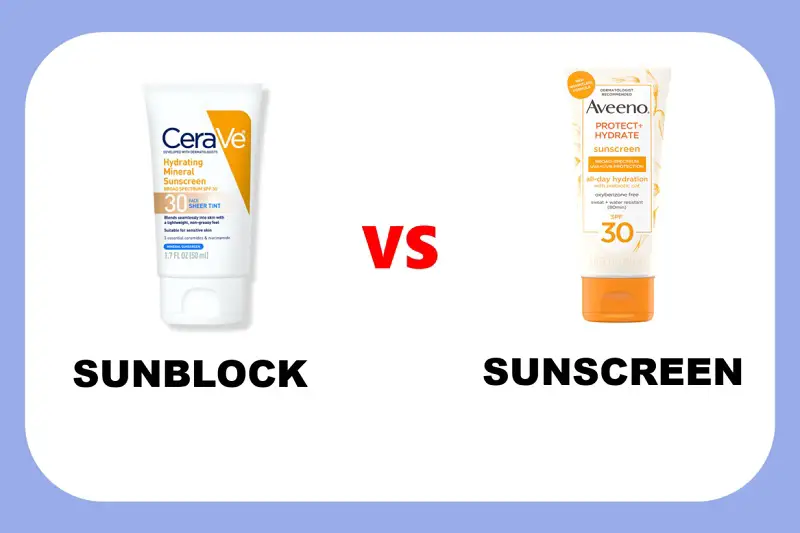As a Malaysian, I was always taught about the importance of using good sunblock to protect my skin from the sun since I was a kid. Over the years, I’ve noticed the term “sunscreen” is used more often than “sunblock.”
As many others have wondered, do they differ or are they the same? Let’s end the misconception about sunblock and sunscreen once and for all.
Table of Contents
ToggleSunblock vs Sunscreen
The main difference between sunblock and sunscreen is that sunblock blocks and reflects sun rays while sunscreen absorbs UV rays and reduces them. But this is only true for years prior to 2011.
Because the term “sunblock” is already banned by FDA in 2011. Among other terms, “waterproof” and “sweatproof” are also prohibited. Thus, almost no products use the term sunblock in their names or descriptions anymore.
Quote from FDA:
“Waterproof,” “sweatproof” or “sunblock” claims. Manufacturers cannot label sunscreens as “waterproof” or “sweatproof,” or identify their products as “sunblocks,” because these claims overstate their effectiveness. Sunscreens also cannot claim to provide sun protection for more than 2 hours without reapplication or to provide protection immediately after application (for example– “instant protection”) without submitting data to support these claims and obtaining FDA approval.
Physical sunscreen vs Chemical sunscreen
Sunblock is now more commonly referred to as physical sunscreen or mineral sunscreen. The main active ingredients in physical sunscreen are zinc oxide or titanium dioxide. They are used to physically block UV rays from reaching the skin.
It forms a physical barrier between the skin and the sun’s rays. As a result, physical sunscreens or sunblocks usually leave a white cast on the skin after application.
On the other hand, sunscreen is now referred to as chemical sunscreen. They usually contain organic chemical compounds such as oxybenzone or avobenzone. These chemicals absorb UV rays and convert them into heat, preventing skin damage from UVA rays.
Since sunscreens are chemically based, they are usually more watery (similar to moisturizer), easier to apply and less visible on the skin.
Comparison table between sunblock and sunscreen
| Sunblock | Sunscreen | |
| Also known as | Physical sunscreen, mineral sunscreen | Chemical sunscreen |
| Protection mechanism | Block and reflect UV rays | Absorb, filter and convert UV Rays |
| Key Ingredients | Titanium dioxide, Zinc dioxide | Oxybenzone, Avobenzone |
| Texture | Thick | Lightweight, non-greasy |
| White cast | Yes | No |
| Effectiveness | Almost immediately | Takes up to 20 minutes for chemical formulas to absorb |
| Environment-friendly | Yes, reef safe | No, coral bleaching |
| Skin-friendly | Yes, less likely to irritate skin | May irritate skin |
| Price | Expensive | Affordable |
Sunblock vs Sunscreen, which is better?
According to the table above, sunblock aka physical sunscreen is better than chemical sunscreen in many ways. In addition to being gentler on the skin, it is also more environmentally friendly.
In general, it provides better sun protection since it reflects instead of absorbs UV rays.
However, its texture is thicker and could leave a white cast on the skin. Therefore, most people would only use sunblock when they were doing outdoor activities or going to the beach.
When it comes to daily use, most people opt for chemical sunscreen because it is more lightweight and doesn’t leave the skin feeling greasy.
Other terms that you should know
Broad-spectrum
Sunscreen that features “Broad-spectrum” means it is effective against both UVA and UVB rays. The sunlight produces three types of UV rays: UVA, UVB, and UVC. Immediate skin tanning and skin ageing is caused by UVA, while sunburn is caused by UVB. The ozone layer absorbs UVC, so it never reaches Earth.
SPF
SPF stands for sun protection factor. Generally speaking, a higher SPF means more sun protection. But, SPF only measures protection against UVB rays. So, you should take note o the PA ratings as well.
Here’s a table of SPF vs UVB blocked percentages:
| SPF value | Percentage of UVB rays blocked |
| SPF 15 | 93% |
| SPF 30 | 97% |
| SPF 50 | 98% |
| SPF70 | 98+% |
| SPF 100 | 99% |
PA+, PA++, PA+++
PA+ stands for Protection Grade of UVA. The “+” sign indicates the strength of protection of UVA of a sunscreen product. PA+ is the lowest level of protection, while PA++++ is the highest level.
Conclusion
Both sunblock and sunscreen are important to provide protection for our skin against harmful UV rays from the sunlight. To protect yourself from the sun in Malaysia, be sure to get one labelled with broad spectrum and with an SPF of at least 30.
FAQ
What is the difference between sunblock and sunscreen?
The key difference between sunblock and sunscreen is sunblock reflects UV rays while sunscreen absorbs them.
Is sunblock or sunscreen more effective at protecting the skin?
Generally, a sunblock, also known as, physical sunscreen is better in protecting the skin from UV rays.
Can I use sunblock and sunscreen together?
No, because sunblock and sunscreen are made of different ingredients and chemical compounds. Sunscreens and sunblocks mixed together may lose their effectiveness or cause skin irritation.
When should I use sunscreen?
It is recommended that Malaysians wear sunscreen every day to prevent premature skin aging.
Can I use sunscreen on babies or toddlers?
Sunscreen should be avoided in babies younger than 6 months old. For babies older than 6 months old or toddlers, it is recommended to only use specifically formulated child-friendly sunscreen.

